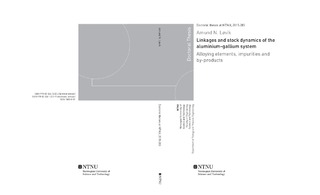| dc.contributor.author | Løvik, Amund Nordli | |
| dc.date.accessioned | 2015-11-26T12:50:38Z | |
| dc.date.available | 2015-11-26T12:50:38Z | |
| dc.date.issued | 2015 | |
| dc.identifier.isbn | 978-82-326-1223-9 | |
| dc.identifier.issn | 1503-8181 | |
| dc.identifier.uri | http://hdl.handle.net/11250/2365872 | |
| dc.description.abstract | Impending global environmental- and resource related problems require a
transformation of the socio-economic metabolism, the inputs, processing and
outputs of materials and energy in society. The environmental impacts and
resource requirements of metal cycles can be reduced significantly if they
approach a steady state where in-use stocks are maintained through recycling
rather than primary metal. In a steady state system, linkages between metal cycles,
for example through alloys, impurities and by-products, will become increasingly
important due to the high share of recycled post-consumer metal. The aluminium
cycle is in this regard particularly important: It is responsible for large greenhouse
gas emissions and energy use, highly sensitive to alloying elements and
impurities, and has a strong linkage to gallium, which is a by-product of
aluminium production. In this thesis, these linkages were studied in the context of
in-use stock saturation and closed-loop material cycles, to better understand their
importance, and to identify strategies that can facilitate a transition towards a
steady-state socio-economic metabolism.
It was found that higher recycling rates are increasingly difficult to achieve in
closed-loop steady state systems, due to the accumulation of impurities. A model
of aluminium beverage can recycling showed that stable metal impurity
concentrations are reached after 5-15 recycling loops with recycling rates in the
range of 45-75%. It is expected that similar results would apply for systems that
are more complex. The increasing availability of automotive aluminium scrap
represents a future challenge for recyclers due to the large variety of alloys and
limited demand for mixed scrap. A global surplus of scrap may occur in the period
2020-2030 unless measures are taken to restructure the recycling system.
Allowing recycled material in safety-relevant components, together with an improved sorting of alloys through dismantling or advanced sorting technologies,
may delay the surplus with several decades.
The global system of production, manufacturing, use and recycling of gallium,
and gallium-containing products was described and quantified for 2011. Gallium
use is currently driven by neodymium-iron-boron magnets containing gallium as
an alloying element and semiconductor applications: integrated circuits, lightemitting
diodes and photovoltaic panels. Large material losses occur in the
fabrication of intermediate products and devices. Currently, demand is far below
the supply potential. Scenario analysis showed that a low stock saturation in the
aluminium cycle might cause the supply potential of gallium to fall below future
demand, given an increased market penetration of gallium-containing
technologies. A number of measures was identified for improving the systemwide
material efficiency, among which the most effective are related to process
yield improvements or collection of production scrap.
The results showed that linkages between material cycles greatly complicate the
transition to a steady-state socio-economic metabolism, and at the same time
indicated priorities for measures that can be taken to facilitate this transition. | nb_NO |
| dc.language.iso | eng | nb_NO |
| dc.publisher | NTNU | nb_NO |
| dc.relation.ispartofseries | Doctoral thesis at NTNU;2015:283 | |
| dc.relation.haspart | Paper 1: Løvik, Amund Nordli; Müller, Daniel Beat. A Material Flow Model for Impurity Accumulation in Beverage Can Recycling Systems. Light Metals 2014 s. 907-911
<a href="http://dx.doi.org/10.1002/9781118888438.ch151" target="_blank"> http://dx.doi.org/10.1002/9781118888438.ch151</a>
© 2014 The Minerals, Metals & Materials Society | nb_NO |
| dc.relation.haspart | Paper 2: Modaresi, Roja; Løvik, Amund Nordli; Müller, Daniel Beat. Component- and Alloy-Specific Modeling for Evaluating Aluminum Recycling Strategies for Vehicles. JOM: The Member Journal of TMS 2014 ;Volum 66.(11) s. 2262-2271
<a href="http://dx.doi.org/10.1007/s11837-014-0900-8" target="_blank"> http://dx.doi.org/10.1007/s11837-014-0900-8</a>
© 2014 The Minerals, Metals & Materials Society | nb_NO |
| dc.relation.haspart | Paper 3: Løvik, Amund Nordli; Modaresi, Roja; Müller, Daniel Beat. Long-term strategies for increased recycling of automotive aluminum and its alloying elements. Environmental Science and Technology 2014 ;Volum 48.(8) s. 4257-4265
<a href="http://dx.doi.org/10.1021/es405604g" target="_blank"> http://dx.doi.org/10.1021/es405604g</a>
© 2014 American Chemical Society | nb_NO |
| dc.relation.haspart | Paper 4: Løvik, Amund Nordli; Restrepo Gomez, Eliette Johana; Müller, Daniel Beat. The global anthropogenic gallium system: Determinants of demand, supply and efficiency improvements. Environmental Science and Technology 2015 ;Volum 49.(9) s. 5704-5712
<a href="http://dx.doi.org/10.1021/acs.est.5b00320" target="_blank"> http://dx.doi.org/10.1021/acs.est.5b00320</a>
© 2015 American Chemical Society | nb_NO |
| dc.relation.haspart | Paper 5: Løvik, A. N.; Restrepo, E.; Müller, D. B., Strategies for securing rising gallium supply under boundary conditions of aluminum stock dynamics | nb_NO |
| dc.title | Linkages and stock dynamics of the aluminium-gallium system: Alloying elements, impurities and by-products | nb_NO |
| dc.type | Doctoral thesis | nb_NO |
| dc.subject.nsi | VDP::Technology: 500::Environmental engineering: 610 | nb_NO |
